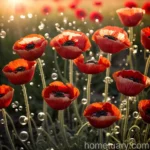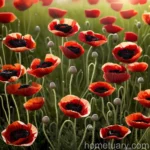The World of Icelandic Poppy (Papaver nudicaule ‘Champagne Bubbles Orange’)
Plants are an integral part of our ecosystem, offering beauty, sustenance, and countless other benefits. Among the diverse range of plants, the Icelandic poppy (Papaver nudicaule ‘Champagne Bubbles Orange’) stands out with its vibrant blooms and unique characteristics. In this comprehensive guide, we’ll delve into the enchanting world of Icelandic poppies, exploring their cultivation, care, and much more.
What is the Icelandic Poppy?
The Icelandic poppy, scientifically known as Papaver nudicaule ‘Champagne Bubbles Orange’, is a delightful flowering plant that belongs to the Papaveraceae family. Originating from the polar regions of Europe, Asia, and North America, these hardy, short-lived perennials are known for their captivating, often orange, cup-shaped blooms. The ‘Champagne Bubbles Orange’ variety, in particular, is celebrated for its stunning display of vibrant, orange petals.
Key Takeaways
Before we dive into the specifics of cultivating and caring for Icelandic poppies, let’s take a moment to highlight some key takeaways about this enchanting plant.
- Icelandic Poppy (Papaver nudicaule ‘Champagne Bubbles Orange’)
- Known for vibrant orange flowers
- Hardy and short-lived perennial
- Belongs to the Papaveraceae family
Now, let’s explore the various aspects of cultivating and nurturing these mesmerizing flowers.
Culture
Understanding the cultural needs of the Icelandic poppy is crucial for fostering its optimal growth and blossoming. Here are some essential cultural considerations for this delightful plant.
Uses
The Icelandic poppy serves various purposes, making it a versatile addition to any garden or landscape. Some of its common uses include:
-
Ornamental Purposes: The bright and cheerful blooms of the ‘Champagne Bubbles Orange’ variety make it a popular choice for ornamental garden displays and floral arrangements.
-
Medicinal: Traditionally, certain poppy species, including the Papaver nudicaule, have been used in herbal medicine for their potential analgesic and sedative properties.
-
Pollinator Attraction: The nectar-rich blossoms of Icelandic poppies attract pollinators, contributing to the overall biodiversity of the garden.
Water
Icelandic poppies thrive in well-drained soil and require moderate watering. Over-watering can lead to root rot, so it is important to strike a balance and allow the soil to dry out between watering sessions.
Sunlight
These poppies prefer full sun to partial shade, with at least 6 hours of direct sunlight to promote healthy growth and abundant flowering.
Fertilizer
A balanced, all-purpose fertilizer can be applied during the growing season to support the Icelandic poppy’s nutritional needs. However, it’s crucial to follow recommended application rates to prevent over-fertilization, which can be detrimental to the plant’s health.
Soil
The Icelandic poppy thrives in well-drained, fertile soil. A slightly acidic to neutral pH level is conducive to its growth, ensuring that it can access essential nutrients for optimal development.
Pruning
Deadheading spent flowers can promote prolonged blooming and prevent self-seeding, allowing the plant to channel its energy into new growth and blooms.
Propagation
Icelandic poppies can be propagated from seeds or by division. The seed propagation process involves sowing seeds in early spring or late summer, while division can be carried out in early spring.
Container Popularity
Due to their relatively compact size, Icelandic poppies are well-suited for container gardens, enhancing patios, balconies, and other confined spaces with their colorful presence.
Common Diseases and Pests
Ensuring a disease and pest-free environment is essential for the well-being of Icelandic poppies. Here are some common diseases, pests, and methods to manage them.
Common Diseases
-
Powdery Mildew: A fungal disease that appears as a white powdery coating on the leaves and stems, often caused by poor air circulation and high humidity. It can be managed by improving air circulation and using fungicidal treatments if necessary.
-
Downy Mildew: Similar to powdery mildew, downy mildew presents as yellow or white patches on the leaves and stems. Adequate air circulation, avoiding overhead watering, and fungicidal treatments can help control this disease.
-
Root Rot: Over-watering and poorly-drained soil can lead to root rot, causing the plant to wilt and decline. Well-drained soil and careful watering practices can prevent this issue.
Disease Diagnosis
Identifying specific diseases in Icelandic poppies involves observing characteristic symptoms such as discoloration, wilting, and abnormal growth patterns. Conducting a thorough examination of the plant and seeking professional guidance can aid in accurate diagnosis and targeted treatment.
Common Pests
-
Aphids: These small, soft-bodied insects can cluster on the stems and leaves, sucking sap from the plant. Physical removal, insecticidal soap, or predatory insects can help manage aphid infestations.
-
Thrips: Thrips are tiny, slender insects that may cause silvery or discolored patches on the foliage. Insecticidal soaps or oils are effective in controlling thrips populations.
-
Slugs and Snails: These mollusks can leave chewed edges and holes in the leaves of Icelandic poppies. Handpicking, barriers, and iron phosphate-based baits are common methods for slug and snail control.
Botanist’s Tips
As a botanist passionate about the beauty and resilience of plants, I’d like to offer some tips for successfully cultivating and caring for Icelandic poppies.
-
Selecting Varieties: Explore the diverse range of Papaver nudicaule varieties to introduce a spectrum of colors and characteristics in your garden. Varieties such as ‘Champagne Bubbles Mix’ and ‘Meadow Pastels’ can add a captivating blend of hues to your outdoor space.
-
Companion Planting: Consider pairing Icelandic poppies with complementary plants such as dianthus, lavender, or salvia to create visually striking and harmonious garden compositions while promoting a balanced ecosystem.
-
Winter Protection: In regions with harsh winters, provide adequate protection such as mulching to shield the plants from extreme cold and fluctuations in temperature, thereby ensuring their survival and reemergence in the following spring.
Fun Facts
To add a touch of fascination to your knowledge of Icelandic poppies, here are some intriguing and delightful fun facts about these enchanting flowers:
-
Symbolism: In addition to being symbols of consolation and remembrance, poppies are associated with wealth and success in Eastern cultures, enriching their significance across various traditions and contexts.
-
Icelandic Origins: Despite their name, Icelandic poppies are not native to Iceland but were given this name due to their vivid presence in the gardens of the country. They thrive in regions with cool, temperate climates, similar to that of Iceland.
Now that we’ve delved into the intricate world of Icelandic poppies, let’s explore some external resources offering valuable insights and information about these captivating plants.
Links to External Resources
- Royal Horticultural Society: Growing Poppies
- The Old Farmer’s Almanac: Growing Poppies
- University of Vermont Extension: Icelandic Poppy Cultivation
- American Meadows: Icelandic Poppy Planting Guide
- Fine Gardening: Poppy Care and Collection
In conclusion, the enchanting allure of Icelandic poppies, exemplified by the ‘Champagne Bubbles Orange’ variety, enriches gardens, landscapes, and floral arrangements with its vibrant colors and charming presence. By adhering to the recommended cultural practices, addressing common diseases and pests, and embracing the intriguing facets of these blooms, you can cultivate a mesmerizing display of Icelandic poppies that captivates and delights all who encounter it.
Now, armed with a deeper understanding of Icelandic poppies, let’s embark on a journey to nurture and celebrate the captivating beauty of these remarkable flowers.
Keywords: Icelandic poppy care, Champagne Bubbles Orange poppy, Papaver nudicaule varieties, how to grow Icelandic poppies, Orange poppy flowers, hardy poppies for gardens, perennial poppy varieties, Icelandic poppy seeds, Papaver nudicaule cultivation, orange poppy plants, Icelandic poppy colors, benefits of growing poppies, growing flowers in Iceland, orange poppy garden design, Icelandic poppy species, Papaver nudicaule characteristics, tips for successful poppy cultivation, winter care for Icelandic poppies, orange Icelandic poppy varieties, poppies with orange blooms, Icelandic poppy symbolism, Papaver nudicaule cultivars, companion plants for poppies, orange flowering perennials, growing poppies for cut flowers, climate requirements for Icelandic poppies, orange poppy plant care, Icelandic poppy disease prevention, Papaver nudicaule hybrids, pest control for poppy plants, orange poppy garden ideas, Icelandic poppies in landscaping, growing poppies from seeds, Papaver nudicaule propagation, orange poppy petal colors, best soil for Icelandic poppies, heat tolerance of orange poppies, Icelandic poppy medicinal uses, pest-resistant poppy varieties, orange poppy plant varieties, Iceland native flowers, growing poppies in containers, Papaver nudicaule life cycle, uses of Icelandic poppy in floral arrangements, orange poppy garden care, Icelandic poppy history and folklore, disease-resistant poppy varieties, orange poppy seasonal blooms, poppies for pollinator gardens, Icelandic poppy propagation techniques















